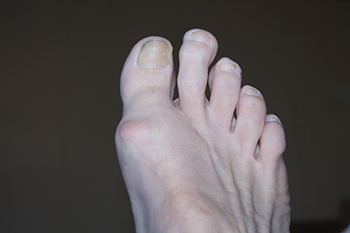Items filtered by date: September 2023
Causes and Solutions for Second Toe Pain

Second toe pain can be a bothersome and discomforting issue, impacting your daily activities and quality of life. Understanding the potential causes and effective treatments is crucial for finding relief and maintaining optimal foot health. One common culprit of second toe pain is wearing improperly fitting shoes. Tight, narrow, or pointy shoes can compress the toes, leading to discomfort and deformities such as hammertoes. High heels, which force excessive weight onto the toes, can exacerbate this problem. Another frequent cause is overuse or repetitive stress, often seen in athletes or individuals engaged in activities that involve pushing off with the toes. This can lead to conditions that can include metatarsalgia or stress fractures. To address second toe pain, begin by wearing comfortable, properly fitting shoes with adequate toe room. Wearing custom orthotics can provide additional support and alleviate pressure. Rest, and taking over-the-counter pain relievers can help manage acute pain, and exercises may be beneficial for chronic issues. If second toe pain persists or worsens, it is suggested that you consult a podiatrist for a proper diagnosis and tailored treatment plan.
Toe pain can disrupt your daily activities. If you have any concerns, contact Dr. Steven Sheridan of Ankle & Foot Specialty Clinics. Our doctor can provide the care you need to keep you pain-free and on your feet.
What Causes Toe Pain?
Most severe toe pain is caused due to a sports injury, trauma from dropping something heavy on the toe, or bumping into something rigid. Other problems can develop over time for various reasons.
Toe pain can be caused by one or more ailments. The most common include:
- Trauma
- Sports injury
- Wearing shoes that are too tight
- Arthritis
- Gout
- Corns and calluses
- Hammertoe
- Bunions
- Blisters
- Ingrown toenails
- Sprains
- Fractures (broken bones)
- Dislocations
When to See a Podiatrist
- Severe pain
- Persistent pain that lasts more than a week
- Signs of infection
- Continued swelling
- Pain that prevents walking
Diagnosis
In many cases the cause of toe pain is obvious, but in others, a podiatrist may want to use more advanced methods to determine the problem. These can range from simple visual inspections and sensation tests to X-rays and MRI scans. Prior medical history, family medical history, and any recent physical traumatic events will all be taken into consideration for a proper diagnosis.
Treatment
Treatments for toe pain and injuries vary and may include shoe inserts, padding, taping, medicines, injections, and in some cases, surgery. If you believe that you have broken a toe, please see a podiatrist as soon as possible.
If you have any questions please feel free to contact our office located in Sandusky, MI . We offer the newest diagnostic tools and technology to treat your foot and ankle needs.
Causes of Ingrown Toenails

Ingrown toenails can be a painful and frustrating condition commonly affecting the big toe. Understanding the causes and appropriate treatment options can help you alleviate discomfort and prevent further complications. One of the causes of ingrown toenails is improper nail trimming. Cutting nails too short or rounding the edges can encourage the nail to grow into the skin. Additionally, wearing tight-fitting shoes that crowd the toes can exert pressure on the toenails, increasing the risk of ingrowth. Trauma or injury to the toe can also be a culprit of ingrown nails. Stubbing your toe or dropping something heavy on it can cause the nail to grow abnormally. To alleviate ingrown toenail pain, the affected foot can be soaked in warm, soapy water to reduce swelling and soften the skin. Proper nail care and wearing comfortable shoes can help prevent this painful condition, ensuring your feet stay healthy and pain-free. If the problem persists or becomes infected, it is suggested that you consult a podiatrist. Antibiotics may be recommended and in severe cases, a minor surgical procedure may be done to remove the ingrown part of the nail.
Ingrown toenails can become painful if they are not treated properly. For more information about ingrown toenails, contact Dr. Steven Sheridan of Ankle & Foot Specialty Clinics. Our doctor can provide the care you need to keep you pain-free and on your feet.
Ingrown Toenails
Ingrown toenails occur when a toenail grows sideways into the bed of the nail, causing pain, swelling, and possibly infection.
Causes
- Bacterial infections
- Improper nail cutting such as cutting it too short or not straight across
- Trauma to the toe, such as stubbing, which causes the nail to grow back irregularly
- Ill-fitting shoes that bunch the toes too close together
- Genetic predisposition
Prevention
Because ingrown toenails are not something found outside of shoe-wearing cultures, going barefoot as often as possible will decrease the likeliness of developing ingrown toenails. Wearing proper fitting shoes and using proper cutting techniques will also help decrease your risk of developing ingrown toenails.
Treatment
Ingrown toenails are a very treatable foot condition. In minor cases, soaking the affected area in salt or antibacterial soaps will not only help with the ingrown nail itself, but also help prevent any infections from occurring. In more severe cases, surgery is an option. In either case, speaking to your podiatrist about this condition will help you get a better understanding of specific treatment options that are right for you.
If you have any questions please feel free to contact our office located in Sandusky, MI . We offer the newest diagnostic and treatment technologies for all your foot and ankle needs.
Why Does My Ankle Crack?

Ankle injuries, particularly sprains, can be debilitating, causing pain and making it difficult to move. After a sprain, some patients may notice a cracking or popping sensation. Ankle cracking often affects those who have experienced multiple ankle sprains because repeated injuries can lead to instability in the joint. Over time, the ligaments that support the ankle become worn down, stretched, and weakened. As a result, they can no longer hold the bones securely in place. When the bones move back into their natural positions, a cracking or popping sound results. Attempting to self-diagnose or treat the issue can lead to further and far more serious complications. Tests such as X-rays can offer a more detailed view of the condition, and the treatment for ankle cracking will depend on the severity of the injury. In many cases, nonsurgical approaches can effectively manage the condition. In extreme cases, surgery may be a necessity. If you experience ankle cracking after a sprain, it's suggested that you make an appointment with a podiatrist for a full exam, diagnosis, and treatment plan.
Ankle sprains are common but need immediate attention. If you need your feet checked, contact Dr. Steven Sheridan from Ankle & Foot Specialty Clinics. Our doctor can provide the care you need to keep you pain-free and on your feet.
How Does an Ankle Sprain Occur?
Ankle sprains take place when the ligaments in your ankle are torn or stretched beyond their limits. There are multiple ways that the ankle can become injured, including twisting or rolling over onto your ankle, putting undue stress on it, or causing trauma to the ankle itself.
What Are the Symptoms?
- Mild to moderate bruising
- Limited mobility
- Swelling
- Discoloration of the skin (depending on severity)
Preventing a Sprain
- Wearing appropriate shoes for the occasion
- Stretching before exercises and sports
- Knowing your limits
Treatment of a Sprain
Treatment of a sprain depends on the severity. Many times, people are told to rest and remain off their feet completely, while others are given an air cast. If the sprain is very severe, surgery may be required.
If you have suffered an ankle sprain previously, you may want to consider additional support such as a brace and regular exercises to strengthen the ankle.
If you have any questions please feel free to contact our office located in Sandusky, MI . We offer the newest diagnostic and treatment technologies for all your foot and ankle needs.
Bunions on the Pinky Toe

A tailor's bunion, also known as a bunionette, is a condition characterized by the formation of a bony lump on the outer side of the little toe. This condition occurs when the fifth metatarsal bone, which is the bottom bone of the little toe, enlarges or shifts outward. Although less common than big toe bunions, a tailor's bunion can still cause discomfort and pain. Symptoms of a tailor's bunion include a swollen bump on the outer side of the toe, which can become red and painful, especially when it rubs against footwear. Tailor's bunions can affect one or both feet. Factors that contribute to the development of tailor's bunions include wearing ill-fitting shoes, being genetically predisposed to structural foot abnormalities, and having loose foot ligaments. A lower-than-normal fifth metatarsal bone or tight calf muscles can also contribute to the condition. In severe cases, surgery may be recommended. For help with a bunionette, it is suggested that you make an appointment with a podiatrist.
If you are suffering from bunion pain, contact Dr. Steven Sheridan of Ankle & Foot Specialty Clinics. Our doctor can provide the care you need to keep you pain-free and on your feet.
What Is a Bunion?
Bunions are painful bony bumps that usually develop on the inside of the foot at the joint of the big toe. As the deformity increases over time, it may become painful to walk and wear shoes. Women are more likely to exacerbate existing bunions since they often wear tight, narrow shoes that shift their toes together. Bunion pain can be relieved by wearing wider shoes with enough room for the toes.
Causes
- Genetics – some people inherit feet that are more prone to bunion development
- Inflammatory Conditions - rheumatoid arthritis and polio may cause bunion development
Symptoms
- Redness and inflammation
- Pain and tenderness
- Callus or corns on the bump
- Restricted motion in the big toe
In order to diagnose your bunion, your podiatrist may ask about your medical history, symptoms, and general health. Your doctor might also order an x-ray to take a closer look at your feet. Nonsurgical treatment options include orthotics, padding, icing, changes in footwear, and medication. If nonsurgical treatments don’t alleviate your bunion pain, surgery may be necessary.
If you have any questions, please feel free to contact our office located in Sandusky, MI . We offer the newest diagnostic and treatment technologies for all your foot care needs.

